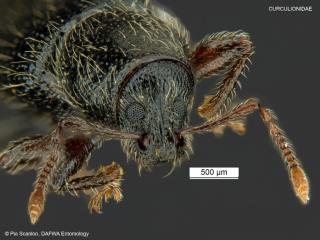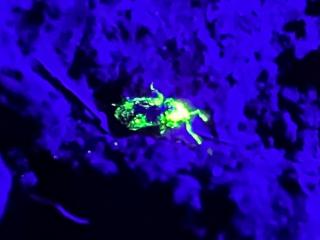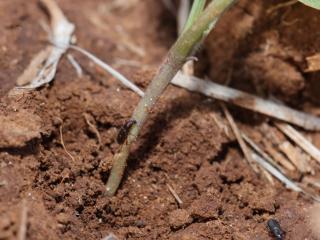The unknown "Dongara" weevil has been attacking canola
- Mingenew
- Dongara
- Mount Budd


An unknown pest weevil has been reported damaging a canola crop near Mingenew by Mingenew Irwin Group (MIG) Project officer Jacqui Meares. Tiny adult weevils were found chewing on the hypocotyl at or just below the soil surface. They are dark brown to black in appearance without prominent markings, approximately 3-5 mm long, and are flightless. They survived typical rates of insecticide used for common pests of canola and are easily confused with desiantha weevils.
Only adults have been found to date and their lifecycle remains unknown. The weevil has previously been reported causing extensive damage in canola and coriander seedling crops grown in heavy fine cracking clay soils in the Mingenew and Dongara areas. It has been dubbed the Dongara weevil referring to the first place from which it was reported in 2013.
The Dongara weevil mostly feeds at night and is elusive during the day usually sheltering in clusters at the base of seedlings or under clods or in deep cracks in heavy fine clay soils. This behaviour is common with many other weevil pests.
The Dongara weevil is smaller and darker in colour than the four species of weevils commonly found damaging canola, vegetable weevil, desiantha (spotted vegetable) weevil, small lucerne weevil and Fuller’s rose weevil. For more information refer to the 2023 PestFacts WA Issue 3 article Identifying weevils.
A joint investigation of the new weevil pest is being undertaken by researchers from DPIRD, MIG and Murdoch University. This research is being co-funded by GRDC and DPIRD. An understanding of the weevil’s host and environmental preferences, along with taxonomic classification will assist with the development of effective management strategies including tools and information to correctly identify the pest.
Surveillance will occur in the 2023 and 2024 seasons, using pitfall traps and opportunistic sampling in paddocks within a 50 km radius of the known Dongara weevil sites. Recently Research scientist Christiaan Valentine (DPIRD) has been tracking the weevil at night with fluorescent powder and a UV light to see how it moves and where it goes.

A taxonomic species description and molecular analysis will be prepared by DPIRD and Murdoch University researchers. It has been confirmed by international weevil specialists that the Dongara weevil does not match any known weevil species worldwide, and it is unlikely to be a native species. The Dongara weevil belongs to the family Curculionidae, the largest insect family in the world with over 300 000 species, and less than one third named in Australia.
Managing Dongara weevils
Preliminary testing of broad-spectrum insecticides have shown that most insecticides registered for weevils in canola performed poorly. Research scientist Dr Dusty Severtson (DPIRD) suggests that the weevils are using avoidance behaviour to evade synthetic pyrethroids such as alphacypermethrin and organophosphates such as chlorpyrifos. He noted that weevils were often found hiding just below the soil surface within furrows at the base of seedlings away from foliar spray exposure.
The registered rate for vegetable weevil, alphacypermethrin at 400 ml/Ha, performed poorly on the Dongara weevil.
Damaged canola crops had also been treated with a neonicotinoid seed dressing and this seems to not bother the weevils at all after being seen feeding on the tiny seedlings.
For more information on weevils visit DPIRD’s Diagnosing weevils in canola and Diagnosing Desiantha weevils in cereals pages.
For more information contact Research scientist Christiaan Valentine, Northam on +61 (0)8 9690 2197.
Article author: Bec Severtson (DPIRD Northam).

